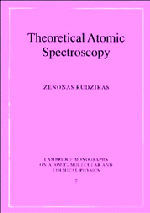Book contents
- Frontmatter
- Contents
- Preface
- Foreword to the Paperback Edition
- Introduction
- Part 1 Energy Spectrum of Many-electron Atom. Radiative and Autoionizing Transitions (Initial Formulas)
- 1 Non-relativistic atomic Hamiltonian and relativistic corrections
- 2 Relativistic atomic Hamiltonian. New wave function
- 3 Perturbation theory for the energy of an atom
- 4 Radiative and autoionizing electronic transitions. Generalized expressions for electric multipole (Ek) transition operators
- Part 2 Foundations of the Angular Momentum Theory. Graphical Methods
- Part 3 Description of Complex Electronic Configurations
- Part 4 Second-quantization in the Theory of an Atom. Quasispin and Isospin
- Part 5 Matrix Elements of the Energy Operator
- Part 6 Electric and Magnetic Multipole Transitions
- Part 7 Calculation of Energy Spectra and Electronic Transitions in the Case of Complex Configurations
- Epilogue
- References
- Index
2 - Relativistic atomic Hamiltonian. New wave function
Published online by Cambridge University Press: 21 September 2009
- Frontmatter
- Contents
- Preface
- Foreword to the Paperback Edition
- Introduction
- Part 1 Energy Spectrum of Many-electron Atom. Radiative and Autoionizing Transitions (Initial Formulas)
- 1 Non-relativistic atomic Hamiltonian and relativistic corrections
- 2 Relativistic atomic Hamiltonian. New wave function
- 3 Perturbation theory for the energy of an atom
- 4 Radiative and autoionizing electronic transitions. Generalized expressions for electric multipole (Ek) transition operators
- Part 2 Foundations of the Angular Momentum Theory. Graphical Methods
- Part 3 Description of Complex Electronic Configurations
- Part 4 Second-quantization in the Theory of an Atom. Quasispin and Isospin
- Part 5 Matrix Elements of the Energy Operator
- Part 6 Electric and Magnetic Multipole Transitions
- Part 7 Calculation of Energy Spectra and Electronic Transitions in the Case of Complex Configurations
- Epilogue
- References
- Index
Summary
Role of relativistic effects
Calculations using the methods of non-relativistic quantum mechanics have now advanced to the point at which they can provide quantitative predictions of the structure and properties of atoms, their ions, molecules, and solids containing atoms from the first two rows of the Periodical Table. However, there is much evidence that relativistic effects grow in importance with the increase of atomic number, and the competition between relativistic and correlation effects dominates over the properties of materials from the first transition row onwards. This makes it obligatory to use methods based on relativistic quantum mechanics if one wishes to obtain even qualitatively realistic descriptions of the properties of systems containing heavy elements. Many of these dominate in materials being considered as new high-temperature superconductors.
It is apparent that progress in our understanding of the properties of neutral heavy elements and their ions, including very highly ionized ones, as well as their role as constituents of molecules and solids, will depend on the development of theoretical methods and computational techniques, which are based on relativistic quantum mechanics. Fairly efficient methods of this kind have already been elaborated and many versions of relativistic codes for work with isolated atoms and ions are already available and in daily use by internationally known theoretical and experimental physicists and chemists.
- Type
- Chapter
- Information
- Theoretical Atomic Spectroscopy , pp. 10 - 15Publisher: Cambridge University PressPrint publication year: 1997



